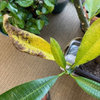Plumeria identification
Mediterranean_Zon10b
9 years ago
Hello , a couple of weeks ago I 've asked a woman for a flower of her frontyard. We exchange a couple of flowers to hand pollinate.
What she gave me ,was a small white flower , with pointed petals and a medium yellow spreading pattern, and a incredible thick texture. Very solid to touch.
Well , the flower is after two weeks being cutted, 14 days!!! In perfect shape. Almost like if It were cutted yesterday or two days ago.
Any suggestion about the name's variety??
Thanks beforehand.


barb13_gw
Mediterranean_Zon10bOriginal Author
Related Professionals
Carlisle Landscape Architects & Landscape Designers · Wrentham Landscape Architects & Landscape Designers · Clark Landscape Architects & Landscape Designers · Prairie Ridge Landscape Architects & Landscape Designers · Zion Landscape Architects & Landscape Designers · Azalea Park Landscape Contractors · Blue Springs Landscape Contractors · Brookline Landscape Contractors · Dallas Landscape Contractors · Muttontown Landscape Contractors · North Lauderdale Landscape Contractors · Raytown Landscape Contractors · Shoreline Siding & Exteriors · Southampton Siding & Exteriors · Weymouth Siding & ExteriorsQHeidi
Florida10
daogirl - SoCal Zone 9
Mediterranean_Zon10bOriginal Author
Loveplants2 8b Virginia Beach, Virginia
daogirl - SoCal Zone 9
Florida10
Loveplants2 8b Virginia Beach, Virginia
jandey1
Florida10
daogirl - SoCal Zone 9
Florida10